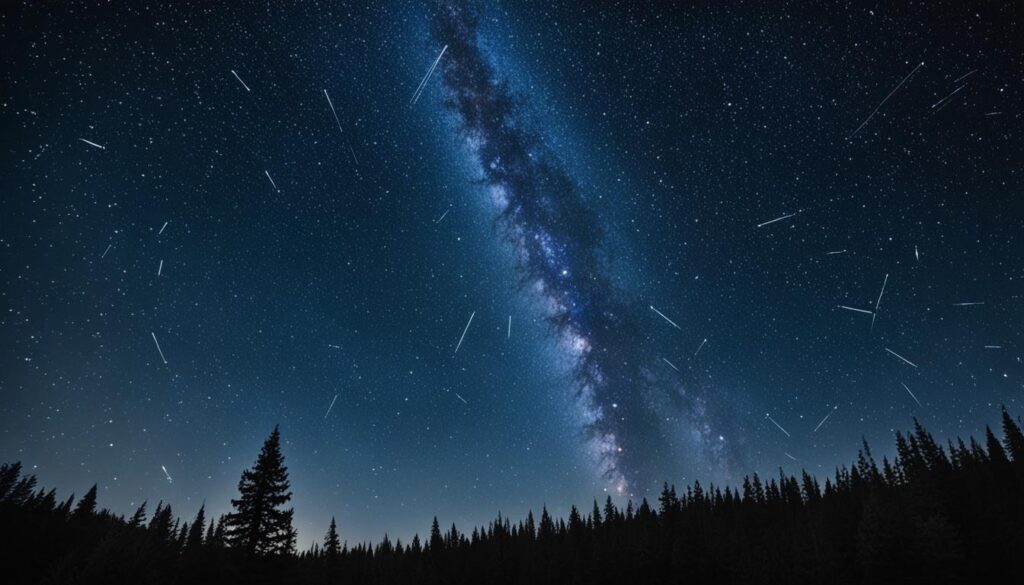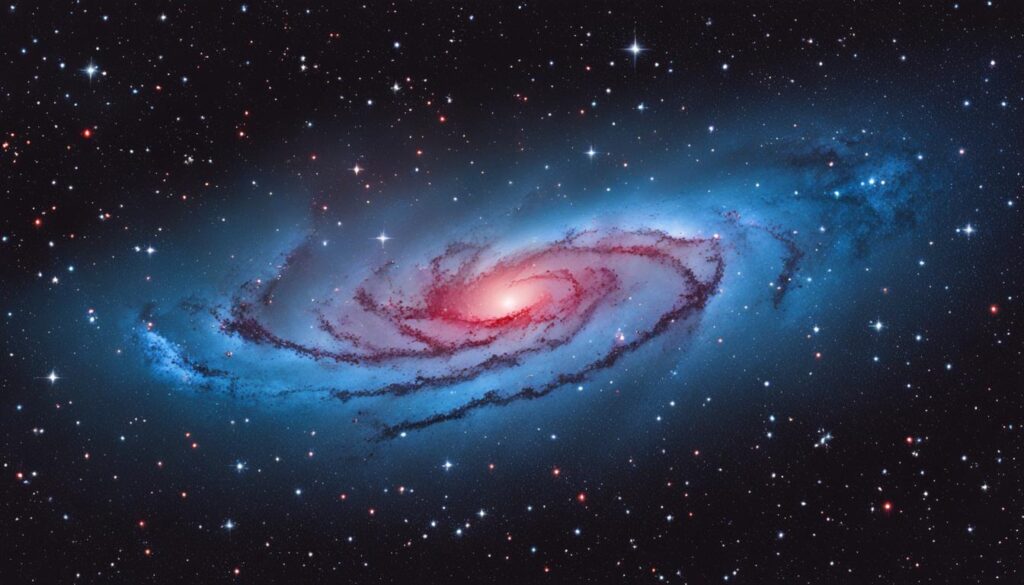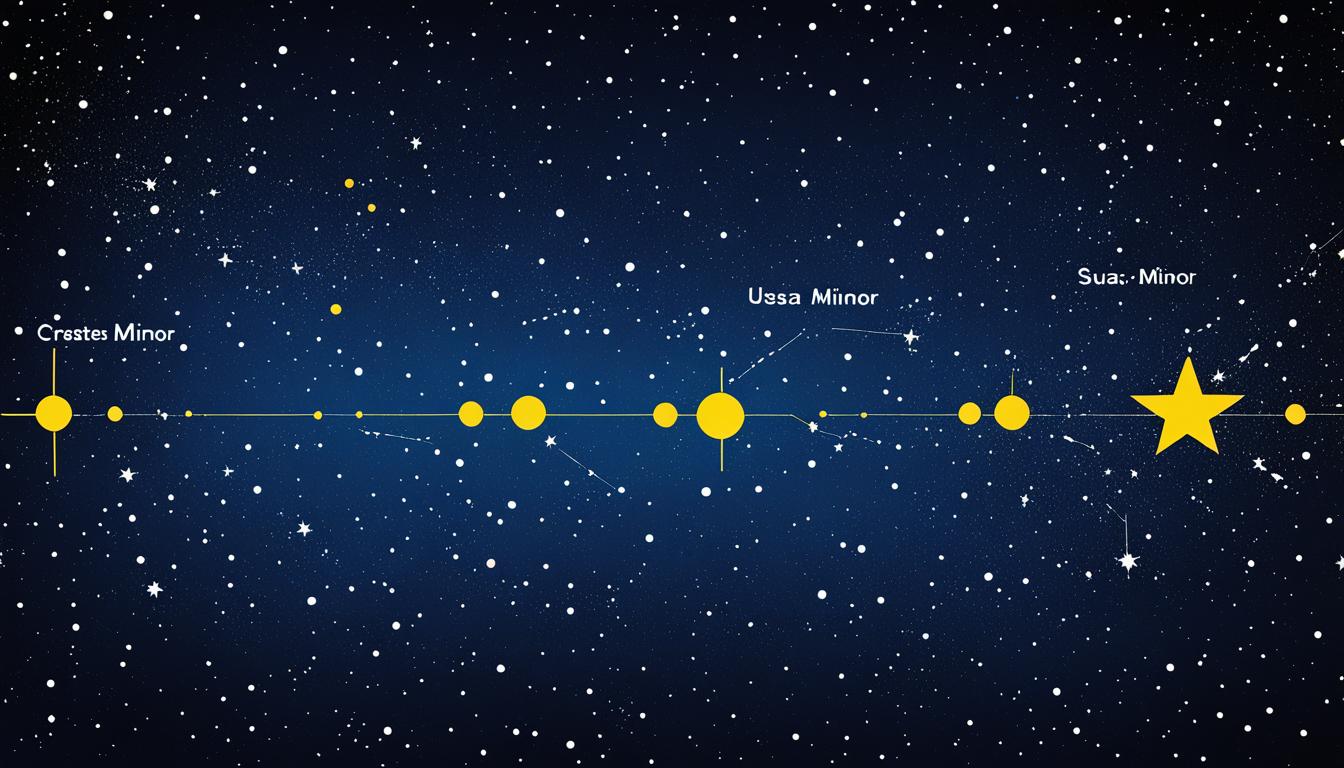| Genitive | |
| Abbreviation | |
| Pronunciation | |
| Main Stars | |
| Brightest Star | |
| Right Ascension | |
| Declination | |
| Sq. Deg. Area | |
| Crosses Meridian | |
| Visible Lat. Range |
As you gaze into the expansive heavens of the Ursa Minor northern hemisphere, you’ll encounter the storied outlines of the Constellation Ursa Minor, a celestial tapestry rich with history and mythology. Meaning “the lesser bear” in Latin, Ursa Minor is not just a ballad of the stars, but also a practical tool for navigation that has been serving mariners, explorers, and stargazers since the 2nd century. It’s time to unfurl the Ursa Minor star chart and embark on an enlightening journey across its 256 square degrees of celestial wonder, marked by the ever-reliable Polaris, the North Star.
Charting your path through the night sky, you’ll find the time-honored Little Dipper asterism as a guide. Allow the rich heritage of the Constellation Ursa Minor to guide you through the cosmos, from navigating ancient seas to locating Polaris, a beacon of constancy for all who seek true north beneath the stars.
Key Takeaways
- Understanding Ursa Minor’s role in celestial navigation, anchored by Polaris.
- Redefining your stargazing with the essential Ursa Minor star chart.
- Exploring the extent of Ursa Minor’s reach in the northern hemisphere.
- Appreciating the historical and cultural significance of this prominent constellation.
- Discovering the constituent stars that make Ursa Minor an astronomical spectacle.
A Journey Through the Mythology of Ursa Minor
Embark on an exploration of the tales and sagas that stitch together the rich Ursa Minor mythology. Discover the constellations’ narratives that have not only filled the celestial canvas with imagination but also established its prominent place in the night sky.
Within Greek mythology, Ursa Minor hosts a pantheon of stories that underscore its importance among the stars. It symbolizes Ida, the nurturing nymph who played a vital role in the upbringing of Zeus. Ensuring his safety, Ida, in one legend, is attributed with cleverly tricking Kronos into swallowing a stone, thus sparing Zeus and eventual rise to power.
Another stirring tale involves Arcas, the offspring of Zeus and the nymph Callisto. Various accounts depict Ursa Minor as Arcas himself, immortalized in the stars, while other stories align the constellation with Boötes, reinforcing the theme of transformation and protection found in Ursa Minor facts.
The Golden Apples narrative featuring the Hesperides, daughters of Atlas, inserts this constellation into the ancient stories as the celestial custodian of Hera’s orchard, etching Ursa Minor’s connection with immortality into the mythology.
You’ll find that these mythological narratives not only emphasize the constellations’ cultural significance but illuminate the past as guides, shaping how we interpret the night sky:
- The tale of Ida links Ursa Minor with nurturing protection
- Arcas’ story infuses the constellation with themes of innocence and metamorphosis
- The Hesperides myth casts the constellation as keepers of the divine, intertwining it with the quest for eternal life
| Mythological Figure | Representation in Ursa Minor | Themes Explored |
|---|---|---|
| Ida | Nurturing Nymph Guardian | Protection, Deception, Care |
| Arcas | Symbolizes Arcas or Associated with Boötes | Innocence, Transformation |
| Hesperides | Custodian of Golden Apples | Immortality, Guardianship |
Ursa Minor’s mythology, as you’ve seen, is as diverse as it is profound, revealing the constellation’s integral role in the stories of antiquity. It has transcended mere celestial navigation to become a repository of legends and cultural identity. By exploring its myths, you’re not just learning about the stars, but also unearthing the timeless human connection to the cosmos.
The Astronomical Significance of Ursa Minor’s Star Patterns
As you delve into the night sky, Ursa Minor might seem modest at a glance, yet its impact on the annals of astronomy is anything but. Central to the Ursa Minor constellation guide is the navigational cornerstone, Polaris, as well as the ensemble of celestial objects that embroider this lesser bear. Let’s embark on a journey to understand the star pattern that has guided humanity throughout the ages.
Home to Polaris: The Guiding North Star
Within the Constellation Ursa Minor, Polaris reigns as the apex of navigational stars. Often dubbed the North Star or Pole Star, Polaris is an F-type supergiant that burns brightly at the tip of the constellation’s tail. Although it sits approximately 434 light-years from Earth, its steadfast position in the Ursa Minor star chart has secured its role in maritime and exploratory history. The legacy of Polaris as an astronomical beacon is undisputed, making Ursa Minor facts about this star essential knowledge for any celestial enthusiast.
The Discovery and Historical Use in Navigation
In ancient times, Thales of Miletus signaled the importance of Ursa Minor to navigation, pivotal knowledge imparted by Phoenician mariners. The constellation’s star names, such as Kochab and Pherkad, were once positioned as pole stars themselves, guiding civilizations long before Polaris took prominence in the skies. In this respect, the study of Ursa Minor celestial objects provides a glimpse into the collective navigational prowess of our ancestors.
A Close Relationship with the Big Dipper
In tracing Ursa Minor’s star pattern, one becomes aware of its intimate connection with the Big Dipper, an asterism within its larger neighbor, Ursa Major. This relationship allows even novice stargazers to glean Ursa Minor facts easily. By extending a line from Merak to Dubhe, the notable pointer stars of the Big Dipper, one can locate Polaris with ease. This alignment not only showcases Ursa Minor’s star chart but also illustrates the fundamental kinship between these northern constellations.
Note: Understanding the Ursa Minor star pattern enhances your astronomical literacy. Remember these pointers as you navigate the celestial sphere:
- Polaris stands as the luminary of Ursa Minor, a steadfast guide over millennia.
- The constellation’s historical use in navigation denotes its importance in world history.
- Ursa Minor’s proximity to the Big Dipper offers a celestial tutorial on locating the North Star.
Whether you are a seasoned astronomer or a curious onlooker, the Constellation Ursa Minor guide provides a window into the timeless dance of the stars.
Essential Facts About the Constellation Ursa Minor
As you explore the night sky of the Ursa Minor northern hemisphere, you’ll come across the remarkable constellation known as Ursa Minor. Packed with intriguing Ursa Minor facts, this constellation, while moderate in size, holds a special place among stargazers and astronomers alike. Its most famous star, Polaris, or the North Star, sits prominently as the gem of this constellation. Embarking on a journey through the cosmic wilderness, you’ll find that Ursa Minor, also known as the Little Bear, is not just a cornerstone of celestial navigation but a treasure trove of celestial lore.

Perhaps lesser known than its eye-catching features is the presence of the dwarf galaxy named after it, the Ursa Minor Dwarf, nestled within its confines. This constellation, occupying a space of 256 square degrees in the sky, ranks as the 56th largest—a true testament to its circumpolar nature that ensures it remains a constant fixture in the Ursa Minor northern hemisphere for those positioned above latitude 25N. For those situated in the further north, Ursa Minor never dips below the horizon, providing a steadfast guide throughout the year.
| Fact | Detail |
|---|---|
| Name Origin | Latin for “Smaller Bear” |
| Brightest Star | Polaris (North Star) |
| Size Ranking | 56th |
| Area | 256 square degrees |
| Notable Object | Ursa Minor Dwarf Galaxy |
| Celestial Position | Circumpolar above latitude 25N |
Grasping the magnitude of Ursa Minor’s influence in the cosmic sea might be daunting, but even a fleeting glance at these facts ensures you can appreciate its prominence in both our past and present astronomical endeavors.
Exploring Ursa Minor’s Notable Celestial Objects
As you embark on a celestial journey through the Ursa Minor constellation, it’s clear that the night sky holds a treasure trove of Ursa Minor stars and deep space phenomena. These stellar and interstellar objects serve as waypoints for Ursa Minor navigation and invite awe from avid stargazers and astronomers alike.
Bright Stars of Ursa Minor and Their Characteristics
Key luminaries such as Polaris, Kochab, and Pherkad are the crown jewels of Ursa Minor star names, each presenting unique attributes that have earned their place in the annals of sky-watching. Let’s delve deeper into the hallmarks that make these stars prominent in the Ursa Minor celestial objects compendium.
| Star Name | Type | Magnitude | Historical Significance |
|---|---|---|---|
| Polaris | Cepheid Variable | 1.97 (Variable) | North Star, Navigational Guide |
| Kochab | Giant Star | 2.08 | Former Pole Star |
| Pherkad | Supergiant | 3.00 | Guard of the Pole |
Deep Sky Objects Within Ursa Minor’s Reach
Enthusiasts of deep sky exploration can marvel at the Ursa Minor Dwarf galaxy, an elusive satellite of our own Milky Way, and the bounteous NGC 6217 galaxy, which is a wondrous sight with its starburst characteristics. While challenging to observe, these deep sky jewels are compelling targets for those equipped with sophisticated telescopes.

Observing the Ursids Meteor Shower
Epitomizing the ephemeral beauty of the cosmos, the Ursids meteor shower emerges as an annual spectacle associated with Ursa Minor. While modest in number, the display can escalate into a remarkable shower, creating an opportunity for you to witness celestial theatrics unfold northwest from Kochab, especially during its peak activity in late December. Whether you’re navigating via the stars or simply soaking in the splendor of the night sky, Ursa Minor’s offerings provide insights and inspiration for all.
Constellation Ursa Minor: Mapping and Best Viewing Practices
Embarking on a stargazing adventure to chart the Ursa Minor constellation is a venture into celestial history and orientation. Armed with a Ursa Minor star chart, you can navigate the 256 square degrees of this lesser yet significant constellation. Visible from the UK and comparable northern latitudes throughout the year, Ursa Minor serves as a constant in the night sky, with optimal visibility in June. When you set your gaze upon the stars of Ursa Minor, you’re not just spotting dots in the dark, rather uncovering a storybook of the cosmos strewn across light-years.
The brilliance of Ursa Minor lies in the unique properties and the varied distances of its stars. While Polaris is a welcomed beacon situated 434 light-years away from Earth, Yildun is a closer celestial neighbor at almost 200 light-years distant. Each star’s distance offers a depth to Ursa Minor navigation, inviting you to discern the subtleties of their luminosity and position. As a constellation that has guided travelers for millennia, drawing your own star chart of Ursa Minor can be both a homage to the ancient mariners and a delightful challenge for contemporary stargazers.
When indulging in this astronomical pursuit, remember that the experience of mapping Ursa Minor enriches your appreciation for these celestial markers. Examine not just their arrangement but also the myth and tradition that orbit each star. Through this lens, the constellation reveals itself as a complex tapestry of Ursa Minor facts and folklore. By tracing this constellation with care and curiosity, you participate in the grand tradition of star navigation and contribute to the ongoing narrative of our shared human connection to the stars above.
Constellation Ursa Minor: Mapping and Best Viewing Practices
What is the Constellation Ursa Minor known for?
The Constellation Ursa Minor is known for containing Polaris (the North Star), which is vital for navigation, and its recognizable asterism, the Little Dipper. It occupies a special place in both astronomy and mythology.
What are the stars that form Ursa Minor’s star pattern?
Ursa Minor’s star pattern, the Little Dipper, is primarily formed by seven stars with five (Baekdu, Kochab, Pherkad, Polaris, and Yildun) being officially named by the International Astronomical Union.
Where and when can I observe the Constellation Ursa Minor in the northern hemisphere?
You can observe the Constellation Ursa Minor throughout the year in the northern hemisphere. For optimal viewing, it is best observed in June from locations with latitudes above 25 degrees North.
Can you share some mythology connected to Ursa Minor?
Ursa Minor is steeped in mythology, with various stories from Greek mythology notably associated with it, such as the tale of Ida, the nymph nurse of Zeus, or sometimes linked to Arcas, the son of Zeus and Callisto. These tales often feature themes of transformation and protection by the gods.
Why is Polaris so significant astronomically?
Polaris, also known as the North Star or Pole Star, is astronomically significant because it is almost directly above the Earth’s north celestial pole, making it an excellent fixed point for celestial navigation and orientation.
Who discovered Ursa Minor’s importance in navigation?
The ancient Greek Thales of Miletus is credited with recognizing Ursa Minor’s significance for navigation, a practice that was influenced by the maritime expertise of the Phoenicians.
How is Ursa Minor related to Ursa Major’s Big Dipper?
Ursa Minor is closely related to the Big Dipper (part of Ursa Major) due to their proximity and similar asterism patterns. The Big Dipper’s pointer stars, Merak and Dubhe, can be used to locate Polaris, the end of the Little Dipper’s handle in Ursa Minor.
What are some important facts about Ursa Minor?
Ursa Minor is a circumpolar constellation visible in the northern hemisphere year-round. It spans 256 square degrees, is the 56th largest constellation, and includes the North Star, Polaris. Despite its size, it lacks prominent deep sky objects except for a few galaxies such as the Ursa Minor Dwarf.
What are the brightest stars in Ursa Minor?
The brightest stars in Ursa Minor include Polaris, the current North Star, Kochab, and Pherkad. These stars are of varying magnitudes, with Polaris being a supergiant star and Kochab once serving as a pole star alongside Pherkad in antiquity.
What deep sky objects are located in Ursa Minor?
The most significant deep sky object in Ursa Minor is the Ursa Minor Dwarf galaxy, a satellite of the Milky Way. Additionally, the galaxy NGC 6217 can be observed within the constellation’s area.
When is the best time to observe the Ursids meteor shower?
The Ursids meteor shower can be observed annually from December 17th to 26th, with the peak activity occurring on the night of December 22nd/23rd when up to 10 or more meteors per hour can be seen radiating from the vicinity of Ursa Minor.
How do I locate Ursa Minor in the sky?
To locate Ursa Minor, first find the Big Dipper in Ursa Major, then use the pointer stars at the end of its bowl to draw an imaginary line extending to Polaris, the brightest star in Ursa Minor, which marks the tip of the Little Dipper’s handle.
What’s the best way to view the stars in Ursa Minor?
The best way to view the stars in Ursa Minor is to choose a dark location with a clear northern horizon, away from light pollution. Use a star chart to help identify the main stars and asterisms, and consider using a telescope to observe fainter celestial objects within the constellation.






